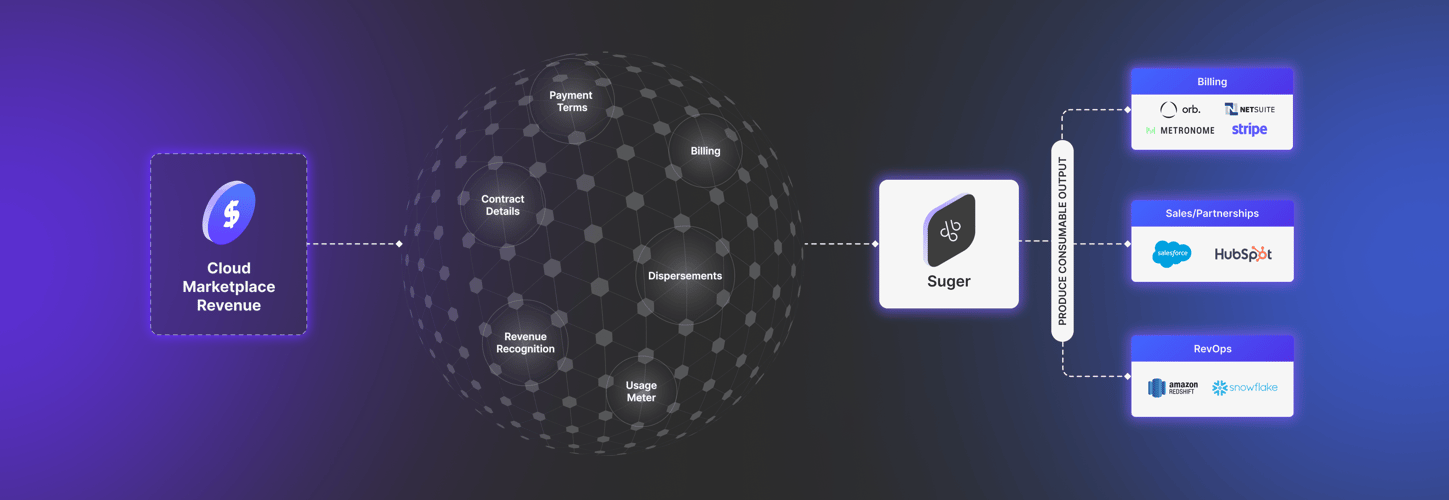Product Led Growth on Cloud Marketplace
Building a PLG strategy on AWS, Azure, and GCP Marketplace
In an era where PLG (Product-Led Growth) dominates discussions, companies are constantly seeking innovative methods to acquire customers with minimal CAC (customer acquisition cost) and streamlined onboarding processes. So, why exactly are cloud marketplaces significant? Many customers and prospects we talk to think about cloud marketplaces as solely a procurement channel to access enterprise cloud budget, which holds some truth.
However, that is not the only way we see customers go to market! There are ways to insert your PLG workflow directly into cloud marketplaces and generate new channels of revenue.
In this article, I'll delve into some key questions that can determine if your product is a suitable fit for self-serve listings on cloud marketplaces. We'll also demonstrate how Suger can simplify a complex quote-to-cash workflow, making it effortlessly simple for various use cases! (see diagram #1 below)

A word of caution: Cloud marketplaces should not be solely relied upon for lead generation. Consider them as supplementary marketing channels, akin to how company mentions in blog posts contribute to SEO but are not the primary content marketing strategy.
What makes your company a good fit?
1. Do you already have a self-serve mechanism in place?
If your company lacks a self-serve or PLG mechanism, experimenting with this change on cloud marketplaces might not be advisable. However, if your product is purchasable on your website, replicating this process on cloud marketplaces can be straightforward with the right tools (ie Suger). We can facilitate the setup of signup redirects and APIs, enabling customers to replicate their exact purchase process while utilizing their cloud marketplace billing.
2. Who are your target personas?
Consider the nature of your product—are you targeting business professionals or developers? When contemplating selling on platforms like AWS, Azure, or GCP, it's important to understand the user base. For instance, if you as a reader unfamiliar with logging into cloud providers websites or creating IAM roles, chances are you're not directly viewing your company's cloud budget. Therefore, developer tools or IT personas with a PLG workflow often fare better on cloud marketplaces. Although this landscape is evolving, with notable business applications like Salesforce listed on AWS, the traction on the PLG side is still developing.
The common use case our customers think about is envision a solo developer attempting to procure your tool through traditional channels. It's likely they're using a personal credit card or seeking budget approval internally just to test products out. Listing your PLG motion on AWS allows individual developers to quickly access cloud budget which in cases can improve conversion rate and speed to purchase.
3. Do you currently attract website traffic?
If you're not already generating organic traffic to your website or social media platforms, cloud marketplaces might not be the most lucrative revenue channel initially. Please note that while this situation could change, cloud marketplaces typically don't attract as much traffic as your own website. A good rule of thumb is if you're not receiving website traffic to your site, you're unlikely to garner it on cloud marketplaces.
To kickstart this process, consider linking your cloud marketplace products on your pricing page to provide customers with an additional procurement channel. Zilliz is a prime example of utilizing their pricing page to facilitate procurement on cloud marketplaces.
Now what?
For all the companies still with questions, we recommend you prioritize setting realistic expectations and outlining the stages of success in the PLG cloud marketplace journey. Like any other channel, this isn't a faucet you can simply turn on or off.
Crawl: Begin by getting listed on your preferred marketplace and guiding a few customers to manually procure your publicly facing product. Assess the demand for this procurement method. In the diagram below, the emphasis during the "Crawl" phase should be placed on the initial step, with the remainder being carried out manually!
Walk: Continue manual efforts while promoting your availability on cloud marketplaces through your website and social channels. Offering customers the option to be redirected to the cloud partner for procurement is key. Subsequently, customers can autonomously navigate their way to the product after purchasing on the cloud marketplace. This stage encompasses the addition of the "Buyer Onboarded" component in the diagram below.
Run: Once you observe an uptick in volume through this channel, shift your focus to step three of the diagram below, which involves implementing automation to scale billing and revenue recognition. Whether it entails integrating metering systems or synchronizing cloud marketplace revenue recognition, Suger can aid in automating every aspect of this journey.

At Suger, we've guided numerous clients through this process. We specialize in this so you can focus on business outcomes rather than complex, homegrown tech solutions. Whether it's PLG on cloud marketplaces or refining your GTM cloud marketplace strategy, we're here to lend a hand. PLG is just one of the many facets we're excited to help you solve!
Learn more about what we do .